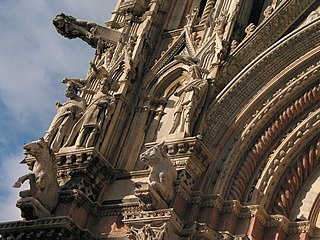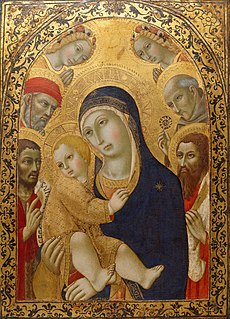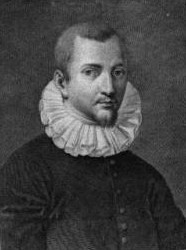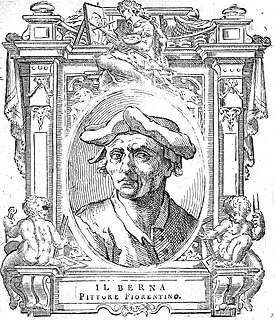Related Research Articles

Duccio di Buoninsegna was an Italian painter active in Siena, Tuscany, in the late 13th and early 14th century. He was hired throughout his life to complete many important works in government and religious buildings around Italy. Duccio is considered one of the greatest Italian painters of the Middle Ages, and is credited with creating the painting styles of Trecento and the Sienese school. He also contributed significantly to the Sienese Gothic style.

Simone Martini was an Italian painter born in Siena. He was a major figure in the development of early Italian painting and greatly influenced the development of the International Gothic style.

Giovanni Pisano was an Italian sculptor, painter and architect, who worked in the cities of Pisa, Siena and Pistoia. He is best known for his sculpture which shows the influence of both the French Gothic and the Ancient Roman art. Henry Moore, referring to his statues for the facade of Siena Cathedral, called him "the first modern sculptor".

Ambrogio Lorenzetti or Ambruogio Laurati was an Italian painter of the Sienese school. He was active from approximately 1317 to 1348. He painted The Allegory of Good and Bad Government in the Sala dei Nove in Siena's Palazzo Pubblico. His elder brother was the painter Pietro Lorenzetti.

Lorenzo di Pietro, known as Vecchietta, was an Italian Sienese School painter, sculptor, goldsmith, and architect of the Renaissance. He is among the artists profiled in Vasari's Le Vite delle più eccellenti pittori, scultori, ed architettori.

Il Sodoma was the name given to the Italian Renaissance painter Giovanni Antonio Bazzi. Il Sodoma painted in a manner that superimposed the High Renaissance style of early 16th-century Rome onto the traditions of the provincial Sienese school; he spent the bulk of his professional life in Siena, with two periods in Rome.

Guido of Siena, was an Italian painter, active during the 13th-century in Siena, and painting in an Italo-Byzantine style.

Francesco di Giorgio Martini (1439–1501) was an Italian architect, engineer, painter, sculptor, and writer. As a painter, he belonged to the Sienese School. He was considered a visionary architectural theorist—in Nikolaus Pevsner's terms: "one of the most interesting later Quattrocento architects". As a military engineer, he executed architectural designs and sculptural projects and built almost seventy fortifications for the Federico da Montefeltro, Count of Urbino, building city walls and early examples of star-shaped fortifications.

Francesco Vanni was an Italian painter, draughtsman, printmaker, publisher and printer active in Rome and his native city of Siena.

Sano di Pietro or Ansano di Pietro di Mencio (1405–1481) was an Italian painter of the Sienese school of painting. He was active for about half a century during the Quattrocento period, and his contemporaries included Giovanni di Paolo and Sassetta.
"The Face Painter" is the 109th episode of NBC sitcom Seinfeld. This is the 22nd episode for the sixth season. It aired on May 11, 1995. The table reading for "The Face Painter" was held on March 26, 1995. In this episode, Jerry, Elaine, Kramer, and David Puddy go to two Stanley Cup playoff games, where Puddy dismays Elaine and an El Salvadoran priest with his rowdy displays of New Jersey Devils fandom. Meanwhile, Kramer holds a grudge against a chimpanzee who hit him with a banana peel, and George resolves to take the dramatic step of telling his girlfriend he loves her.

Matteo di Giovanni was an Italian Renaissance artist from the Sienese School.

Bartolo di Fredi, also called Bartolo Battiloro, was an Italian painter, born in Siena, classified as a member of the Sienese School.

Rutilio di Lorenzo Manetti was an Italian painter of late-Mannerism or proto-Baroque, active mainly in Siena.

Neroccio di Bartolomeo de' Landi (1447–1500) was an Italian painter and sculptor of the early-Renaissance or Quattrocento period in Siena.

Barna da Siena, also known as Berna di Siena, was presumed to be a Sienese painter active from about 1330 to 1350.

Andrea di Bartolo or Andrea di Bartolo Cini was an Italian painter, stained glass designer and illuminator of the Sienese School mainly known for his religious subjects. He was active between 1389–1428 in the area in and around Siena.

The Italian painter and engraver Bernardino Mei worked in a Baroque manner in his native Siena and in Rome, finding patronage above all in the Chigi family.

Madonna and Child with St. John the Baptist and St. Mary Magdalene is a painting by Neroccio di Bartolomeo de' Landi. The painting is a tempera on wood from 1495. It is currently held by the Indianapolis Museum of Art.
Costalpino is a village in Tuscany, central Italy, in the comune of Siena, province of Siena.
References
- Bryan, Michael (1889). Walter Armstrong; Robert Edmund Graves (eds.). Dictionary of Painters and Engravers, Biographical and Critical. Vol. II L-Z. London: George Bell and Sons. p. 590.